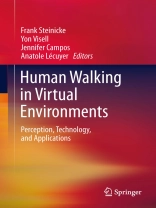This book presents a survey of past and recent developments on human walking in virtual environments with an emphasis on human self-motion perception, the multisensory nature of experiences of walking, conceptual design approaches, current technologies, and applications. The use of Virtual Reality and movement simulation systems is becoming increasingly popular and more accessible to a wide variety of research fields and applications. While, in the past, simulation technologies have focused on developing realistic, interactive visual environments, it is becoming increasingly obvious that our everyday interactions are highly multisensory. Therefore, investigators are beginning to understand the critical importance of developing and validating locomotor interfaces that can allow for realistic, natural behaviours. The book aims to present an overview of what is currently understood about human perception and performance when moving in virtual environments and to situate it relative to the broader scientific and engineering literature on human locomotion and locomotion interfaces. The contents include scientific background and recent empirical findings related to biomechanics, self-motion perception, and physical interactions. The book also discusses conceptual approaches to multimodal sensing, display systems, and interaction for walking in real and virtual environments. Finally, it will present current and emerging applications in areas such as gait and posture rehabilitation, gaming, sports, and architectural design.
Cuprins
Sensory contributions to spatial knowledge of real and virtual environments.- Perceptual and cognitive factors for self‐motion simulation in virtual environments.- Biomechanics of walking in real world: naturalness we wish to reach in virtual reality.- Affordance perception and the visual control of locomotion.- The effect of translational and rotational body-based information on navigation.- Enabling unconstrained omnidirectional walking through virtual environments: an overview of the Cyber Walk project.- Displays and Interaction for Virtual Travel.- Sensing Human Walking: Algorithms and Techniques for Extracting and Modeling Locomotion.- Technologies in Locomotion Interface.- Implementing Virtual Walking.- Virtual Locomotion using a Walking Metaphor.- Multimodal Rendering of Walking over Virtual Grounds.- Displacements in Virtual Reality applications for sports.- Redirected Walking in Mixed Reality Training Applications.- VR-based Assessment and Rehabilitation of Functional Mobility.- Full Body Locomotion with Video Game Motion Controllers.- Interacting with augmented floor surfaces.- A mobile virtual training system for military purposes.
Despre autor
Frank Steinicke is a professor of computer science in media at the Department of Computer Science and the Department of Human-Computer-Media at the University of Würzburg. He received his Ph.D. in computer science from the University of Munster.
Yon Visell is assistant professor at Drexel University in Philadelphia, in the Department of Electrical and Computer Engineering. His research concerns engineering and scientific aspects of haptic and multisensory interaction in virtual and augmented reality environments.
Dr. Campos is a Scientist at Toronto Rehab where her research focus is on multisensory integration, perception-action coupling and visuomotor control.
Anatole Lécuyer is a senior researcher at Inria in Rennes, France. His research concerns Virtual Reality, 3D User Interfaces, Haptic Feedback and Brain-Computer Interfaces.












